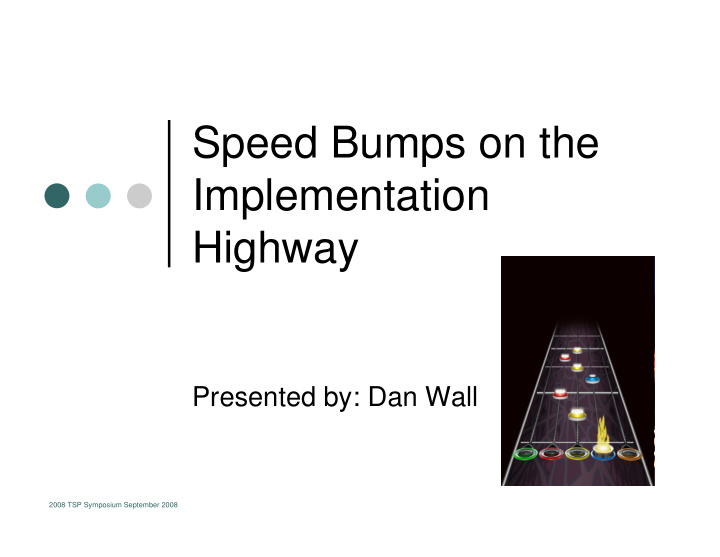



Speed Bumps on the Implementation Highway Presented by: Dan Wall 2008 TSP Symposium September 2008
SEI Approach - 1 The TSP introduction approach must be unique for each � organization. Start with two to four TSP prototype projects. � Define the prototype goals. Define the prototype goals. � � Establish responsibilities. � Get started. � First steps � train a few pilot TSP teams and their managers � launch the teams � gather data and evaluate the results � train internal instructors and coaches � 2 2008 TSP Symposium
Introduction Timeline � Example timeline � based on 9-12 month pilot projects � initial results available in 6-12 months � final results available in 12-18 months � demonstrates TSP benefits � demonstrates TSP benefits � rapidly builds high-performance teams Task Q1 Q2 Q3 Q4 Q5 Q6 Executive training/kickoff session X Select participants, develop schedule X Train managers, developers, instructors X X X Conduct TSP pilots X X Build introduction team X X Plan and initiate roll-out X 3 2008 TSP Symposium
Bump 10- Not Talking Many other organizations have implemented the TSP � talk to as many organizations as you can can • Pick their brains what worked, what didn't • Why were they successful or not • What results did they achieve • How did they train there people • Share 4 2008 TSP Symposium
Bump 6 – The Right Help Most organizations do not start with internal coaching and training capabilities � Pick someone that meshes with your � Pick someone that meshes with your organization • Background • Philosophy • Availability • Experience and track record • Rapport 5 2008 TSP Symposium
Bump 11- Transition Team You need a transition team, not just one person Appoint a transition lead and train them � The transition team is responsible for � establishing the transition plan � negotiating this plan � reviewing the plan with senior management � monitoring and guiding the transition effort � leading the dedicated transition resources 6 2008 TSP Symposium
Bump 3 – Training � We all know the SEI recommends that everyone be trained. We all skimp on it How many of us actually get How many of us actually get everyone trained and keep up with the training of new people? Launches and your support efforts are much easier if everyone if trained 7 2008 TSP Symposium
Required Training � Executive strategy and planning seminar: 1 1/2 days � Management training: 2 days � Required team member training � Required team member training � two-week PSP course for software professionals � two-day personal process course for other professionals � Internal instructor/coach training � PSP instructor: 5 days � TSP launch coach: 5 days 8 2008 TSP Symposium
Bump 1 – Sr. Management Sr. management support is absolutely necessary � They need understand what is going to happen and how it impacts them � If it is important to them it will be important to the rest of the organization � Make sure they stay involved • Consider them TSP team 9 2008 TSP Symposium
Bump 8 – Measurements � Again the advice from the SEI is development success criteria ..most don’t Define what success will look like • Use SMART measures • Have senior, middle management and project team develop and monitor them 10 2008 TSP Symposium
Bump 9 – Technology � Adapt and use any PI technology that will help you solve your organizations problems as you implement TSP & PSP � CMMI PAs, Six Sigma, Lean techniques � CMMI PAs, Six Sigma, Lean techniques � Find the tool set the best fits your needs and use it � E.g. SEI Spreadsheet, Process Dashboard, MS Project, DevTrak 11 2008 TSP Symposium
Bump 2 – Middle Management At first appearance they aren’t impacted – but their role changes the most � They need careful handling and feeding throughout the pilot and more importantly through rollout � Keep them involved � Reviews, roundtables, 1-1s 12 2008 TSP Symposium
Bump 4 –Patience Process Improvement is hard work � Most senior management wants the results as soon as possible results as soon as possible � Resist the temptation to go fast � Everyone needs care and feeding � Middle Management and Dev teams often like the status quo 13 2008 TSP Symposium
Bump 5 – Listen Often we just move ahead with the plan and don’t listen to the people � What are the problems, what are their concerns • Address them as you move forward • Involve the organization in the change, not just with the training 14 2008 TSP Symposium
Bump 7 – Internal Capabilities Having consultants on site is great but in the end most organizations can’t afford them, plus they don’t live with your problems. � Develop your own internal capabilities to support your organization. They know the people, the culture, the opinion leaders and they have a vested interest in succeeding. • Plan ahead for required resources • Transition plan for coaches and instructors 15 2008 TSP Symposium
Questions 16 2008 TSP Symposium
Contact Dan Wall Vice President – Production Methods Vicarious Visions 150 Broadway Suite 205 Albany, NY 12204 518-701-2512 17 2008 TSP Symposium
Recommend
More recommend